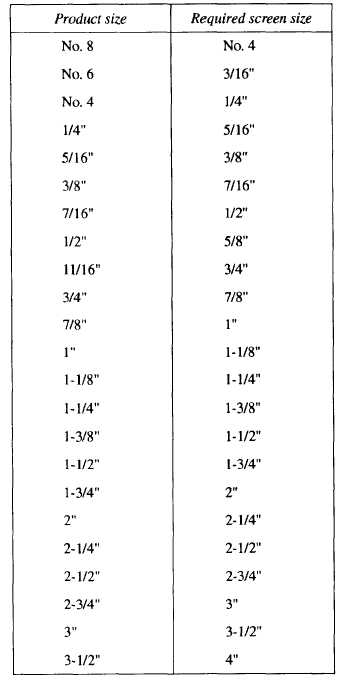screen out fines. This enables you to direct certain
selected material to receive special or additional
processing. Certain material may also be directed to
bypass processing that is not required.
Screens consist of two, three, or four layers or decks
of open-mesh screen wire cloth, mounted one above the
other in a rectangular metal box. The screen surfaces are
vibrated to aid sorting. Material is fed at one end and is
separated into size ranges as it passes over the screening
surface. The screening process is based upon the fact
that particle sizes smaller than the screen cloth opening
size passes through the screen and oversized particles
are retained.
Stratification of the feed material must occur
rapidly as the material is passed over the screen surface
to obtain good efficiency and high capacity. This ensures
the smaller particles can move quickly to the bottom and
fall through the screen openings, and the larger
oversized particles are carried to the top of the feed
stream where they are retained and directed off the end
of the screen. The desired performance of specific
screens is obtained by varying the degree of inclination,
frequency and amplitude of stroke, and the direction of
throw. Screens may be horizontal or inclined up to about
20 degrees and vibrate at 850 to 1,250 strokes per
minute, depending upon the particular application.
CAPACITY.– Capacity is the rate in tons per hour
at which a screen produces (passes) the material desired.
The capacity of a screen is the rate at which it separates
desired material from the feed.
FEEDING MATERIALS TO SCREEN.– Care
must be taken to spread the flow of material evenly
across the full width of the screen. The thickness of the
bed of feed material should be approximately four times
the screen opening size. If this is exceeded, the screen
becomes overloaded and the vibrations are dampened.
This results in the finer particles being unable to find
their way to the screen wire opening. When an
insufficient amount of material is fed, the total capacity
of the screen is not used.
VARIABLE FACTORS.– Numerous factors can
affect the performance of screens. Some examples of
these are as follows: shapes, weight, and gradation of
particles; degree of inclination and vibration; type of
wire screen cloth; position of the screen within the deck;
and wet screening (washing).
Screen Selection
Once the gradation of material has been determined,
screens must be selected that can segregate the materials
into appropriate sizes. The number of screens to be
selected is dependent upon the number of size ranges
into which the material must be segregated and the type
of equipment available for screening. Table 6-1 gives
the screen sizes of vibrating screens used to produce
specific sizes of aggregate.
Table 61.-Vibrating Screen Selection Chart
6-9

